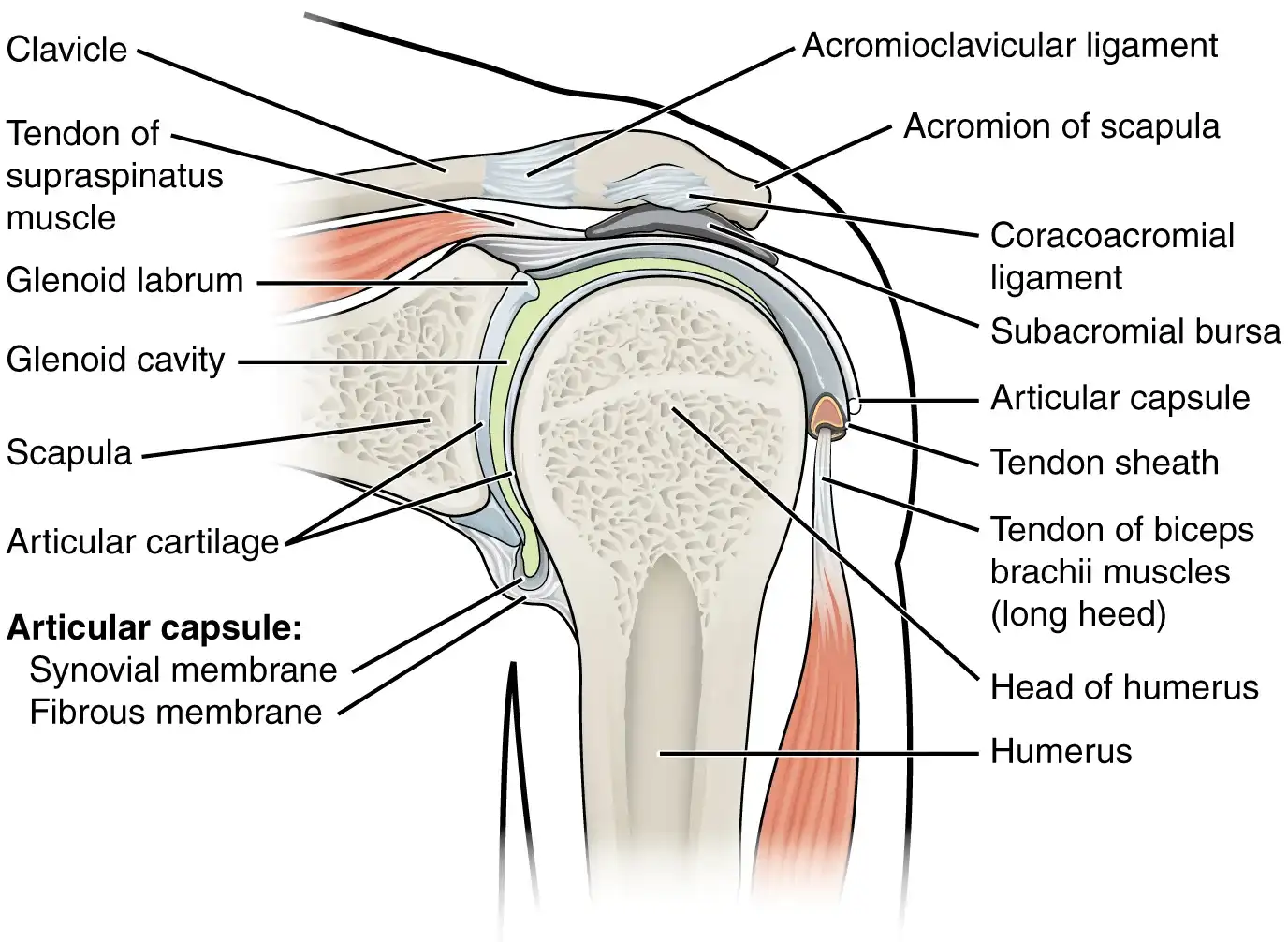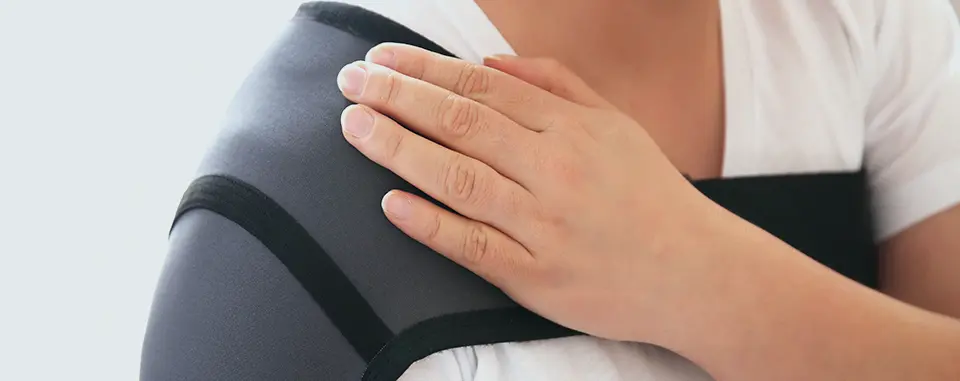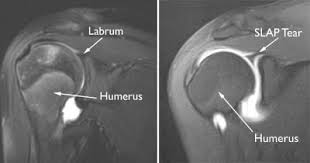Shoulder Stabilisation
Shoulder stabilisation and labral/SLAP repairs are surgical procedures aimed at addressing instability and tears in the labrum, respectively. Due to its wide range of motion, the shoulder joint is susceptible to injuries such as labral tears and SLAP (superior labrum anterior-posterior) lesions. These procedures aim to restore stability, alleviate pain, and improve function in the shoulder joint.
Anatomy of the Shoulder

shoulder anatomy
Shoulder Anatomy by OpenStax/CC BY 4.0
The shoulder joint consists of the humerus (upper arm bone), scapula (shoulder blade), and clavicle (collarbone). The glenoid, a shallow socket in the scapula, articulates with the humeral head to form the shoulder joint. The labrum is a fibrocartilage structure that surrounds the glenoid, deepening the socket and providing stability to the joint. The biceps tendon attaches to the superior labrum and plays a role in shoulder function.
Types of Conditions Requiring Shoulder Stabilisation or Labral/SLAP Repair
These procedures are indicated for various shoulder conditions, including:
- Traumatic dislocations leading to labral tears
- Repetitive overhead activities causing SLAP lesions
- Instability resulting from ligament laxity or bone abnormalities
- Persistent shoulder pain and dysfunction despite conservative treatment
Types of Shoulder Stabilisation Surgeries
Labral Repair
A labral repair is a surgical procedure aimed at addressing tears in the labrum, a cartilage structure that helps stabilise the shoulder joint. When the labrum is torn, it can lead to shoulder instability, pain, and reduced function. Dr. Soong Chua specialises in performing this procedure using arthroscopic techniques, which involve making small incisions and using a camera called an arthroscope to visualise and repair the damaged area.
During the procedure, you will be under general anaesthesia, and a nerve block may also be administered to minimise postoperative discomfort. Through tiny incisions, the arthroscope is inserted, providing Dr. Chua with clear images of the inside of your shoulder joint displayed on a video screen.
With the help of these images, Dr. Chua will meticulously inspect the damaged area and identify the labral tear. Special anchors equipped with strong sutures are then used to reattach the torn labrum to the bone. Depending on the extent of the injury, adjacent tissue and additional anchors may also be utilised for comprehensive repair.
SLAP Repair
SLAP repair is a surgical procedure aimed at addressing superior labrum anterior-posterior (SLAP) tears. This procedure involves reattaching the torn labrum at the top of the glenoid, where the biceps tendon attaches. SLAP tears are common in athletes who perform repetitive overhead motions.
Benefits and Risks of Shoulder Stabilisation
Benefits
- Restored Stability and Range of Motion: By repairing torn labrum or stabilising the shoulder joint, these procedures can restore stability and improve the range of motion in the shoulder. This can allow patients to perform daily activities and participate in sports or recreational activities without experiencing pain or instability.
- Reduced Pain and Improved Shoulder Function: Repairing labral tears or SLAP lesions can alleviate shoulder pain and improve overall shoulder function. Patients may experience increased strength, endurance, and mobility in the shoulder joint, allowing for better quality of life and participation in physical activities.
- Prevention of Further Damage to the Shoulder Joint: Addressing underlying shoulder pathology through surgical intervention can prevent further damage to the shoulder joint. By stabilising the shoulder or repairing labral tears, these procedures can reduce the risk of recurrent dislocations, degenerative changes, and other complications associated with untreated shoulder injuries.
Risks
- Infection
- Nerve or blood vessel injury
- Stiffness or weakness in the shoulder
- Failure of the repair requiring revision surgery
What to Expect
Before Surgery
Dr Chua will conduct a comprehensive evaluation of your shoulder, which may include a physical examination, imaging studies (such as X-rays, MRI, or CT scans), and a review of your medical history. This evaluation helps assess the extent of the shoulder injury and determine the most appropriate surgical approach.
You will receive specific instructions from your healthcare team regarding preoperative preparations. These instructions may include fasting for a certain period before surgery, discontinuation of certain medications (such as blood thinners) that could increase the risk of bleeding during surgery, and arrangements for transportation to and from the hospital or surgical facility.
You may undergo a preoperative anaesthesia consultation to assess your medical fitness for anaesthesia and discuss anaesthesia-related considerations, such as fasting guidelines and potential side effects.
During Surgery
The surgical procedure is typically performed arthroscopically, using minimally invasive techniques. This approach involves making small incisions (known as portals) around the shoulder joint and inserting a tiny camera called an arthroscope, which allows the surgeon to visualise the inside of the shoulder joint on a monitor.
Patients are typically placed under general anaesthesia for shoulder stabilisation or labral and SLAP repair surgery. This means you will be unconscious and unable to feel pain during the procedure. In some cases, regional anaesthesia techniques, such as nerve blocks, may also be used to provide additional pain relief and reduce the need for opioid pain medications postoperatively.
The duration of shoulder stabilisation or labral repair surgery varies depending on the complexity of the procedure and any additional interventions that may be required. Your surgeon will provide you with an estimated duration of the surgery during the preoperative consultation.
After Surgery
Once the surgery is over, patients will be moved to a recovery room with their shoulder immobilised in a sling, which will need to stay in place for around 4 to 6 weeks. A physiotherapist will provide instructions on postoperative care and initiate a rehabilitation program to promote healing and restore shoulder function.
Most patients can leave the hospital the day after surgery. Follow-up appointments with Dr Chua will be scheduled to monitor progress and adjust the treatment plan as needed.

Conclusion
Shoulder stabilisation and labral repairs are vital surgical interventions aimed at addressing shoulder instability, labral tears, and SLAP lesions, restoring stability, alleviating pain, and improving function in the shoulder joint.
These procedures are particularly beneficial for individuals with traumatic dislocations, repetitive overhead activities-related injuries, ligament laxity, or persistent shoulder pain despite conservative treatment. Dr. Soong Chua specializes in performing these procedures using advanced arthroscopic techniques, ensuring optimal outcomes with minimal invasiveness.
If you’re experiencing shoulder issues, don’t hesitate to consult with Dr. Chua to explore your treatment options and regain shoulder function and comfort.
Frequently Asked Questions
- How long does it take to recover from shoulder stabilisation and labral/SLAP repairs?
Recovery time varies depending on the extent of the injury and the individual’s healing process. Generally, patients can expect to regain full shoulder function within 4 to 6 months with diligent rehabilitation. - Are there any restrictions or precautions after surgery?
Patients may need to avoid certain activities, such as lifting heavy objects or engaging in strenuous exercise, during the initial phase of recovery. Following the rehabilitation program prescribed by the physiotherapist is crucial for optimal outcomes. - What are the success rates of shoulder stabilisation and labral repairs?
Success rates vary depending on factors such as the severity of the injury, patient compliance with rehabilitation, and surgical technique. Overall, these procedures have been shown to effectively restore shoulder stability and function in the majority of patients.


